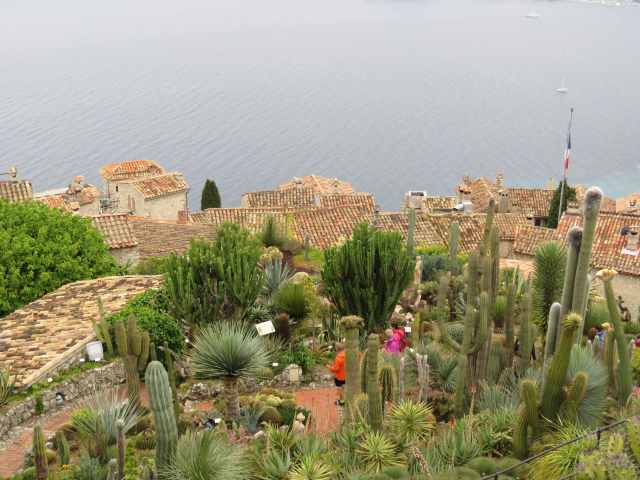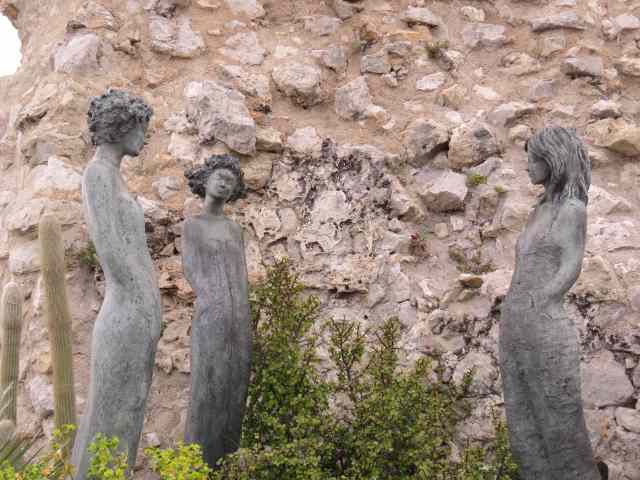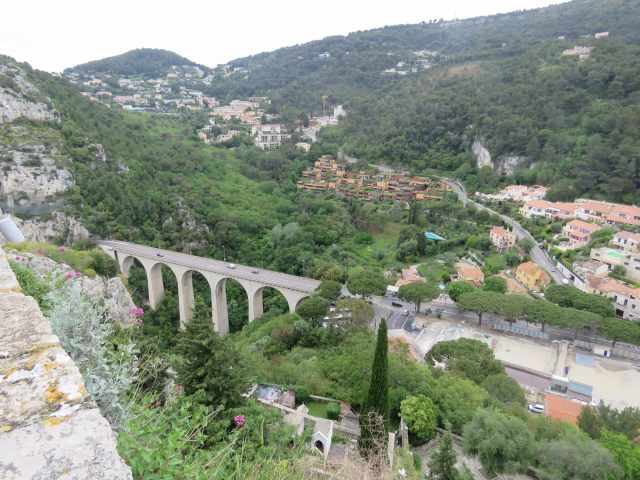
From the Ephrussi de Rothschild garden, it was on to the village of Èze and its famed Jardin Exotique. Èze is pronounced somewhere between ‘ezz’ and ‘airz’, not to be confused with the modern, novelty spelling of ‘easy’ – as in the Eze Wash carwash franchise I drive past as I go to town. I feel the village of Èze deserves more respect than that.


A few km north of Nice, Èze is recorded as having been occupied since 200BC. Its long history involves the Romans, Moors, Italians, French, Spanish and Turks. Surprisingly, it has only been formally French since the 1860s. It has attracted so much interest because the fortified village is on an elevated promontory with cliffs on the seaward side and views right around, making it both strategic and defendable. The fortifications tell quite a story.

The village layout and buildings date back to the early 14th century, although fragments of walls from those BC times, 14 or 15 centuries earlier, still exist. Significantly, there is no vehicle access into the village. Everything comes in and out by hand and manual trolley. Well, almost everything but more on that later. It seems the two hotels in the old village use porters. I laughed when I looked up accommodation in Èze, just out of curiosity. There was a review, clearly of a place by the new town, not the medieval village, and written by an American. “We could walk to the grocery, quiche place, bus, and to the old city of Eze. All the other accommodations I saw were on hilly roads without sidewalks.”
Pretty much the whole of the French Riviera I saw is built on steep hills with uneven terrain, narrow, winding roads and certainly no footpaths outside of urban centres. Every road was a foot path for centuries of occupants here, long before the car was even thought of. This is not a place for people with restricted mobility.

Above the village, at the highest point, stand the ruins of a fortified castle, sacked in 1706 by the soldiers of French King Louis XIV. At that point Èze was still under the control of the House of Savoy, so Italian, but largely inhabited by people known as Ezasques. Interestingly, the native dialect of Èze – rarely used nowadays – is most closely related to the Monegasque language of nearby Monaco. I find Europe’s fluid land borders fascinating.

The ExotIc Garden is positively modern because it only dates back to 1949. Just down the road, so to speak, Jean Gaustad had already played a major role in creating the Jardin Exotique de Monaco. The mayor of Èze apparently thought it would be a good idea for his area too, as he is credited with a role in creating the Èze garden. Conditions are tough – exposed, coastal, precipitous, rocky, windy, very dry and hot in summer. What grows in those conditions? Cacti and succulents. They grow very well. I see a note that in getting the garden established, crews of men carted soil up the hill in bags on their backs so clearly efforts were made to give the plants a good start.

I am not a fan of prickly plants in any way, shape or form but they look right at home in these exposed conditions and I was somewhat won over by their textures and colours. Being a designated botanic garden, plants are all labelled. The gardener in me finds my eyes zooming in on those white labels and the aesthetics worry me but labels are the way in public and botanic gardens; private gardens need to make their labelling very discreet or non-existent to avoid looking amenity or municipal, in my opinion.

I felt obliged to photograph the tree fern out of southern loyalty. Truth be told, it is probably the Australian Dicksonia antarctica rather than one of our NZ species. It seems to be more widely available in Europe and Australian plants were being widely grown in the area whereas NZ plants were rare. But you know, we claim all tree ferns as ours, in an inclusive sort of way.


The setting is amazing with 360° views. It is a long way down, whether on the land side or even further down to the sea. Apparently the Irish rock star Bono (of U2 and social activism fame) has a house down by the sea and the story is that he and his good friend Barack Obama walked up the hill for a drink at the hotel in the old village, somewhat to the surprise of village and garden visitors. All I could think was that if they walked all the way up there from the sea, they deserved a long, cold drink in peace.

The aspect of this garden that did worry me was the answer I was given to how they got large plants and sculptures to the upper levels. I didn’t think they were being levered around the tight lanes and steep steps. Helicopter, I was told, with the additional information that garden waste is also lifted out by helicopter. Surely not? Colour me shocked. In 2024, I would expect garden waste to be dealt with on site in a sustainable way, not loaded into bags to be airlifted out. I hope the information I was given is wrong but I fear it may be accurate.



The Earth Goddess sculptures were an interesting, contemporary touch. Jean-Philippe Richard started on his earth goddess works in the 1990s. Their elegant, elongated bodies stretch from chunky bases as though emerging from the earth and metamorphosing into stylised interpretations of classical, maybe stereotypical, feminine beauty. They were striking and after my reservations about the cliches of feminine beauty (I kept looking in hope that they may be either androgynous or maybe include some examples of young male beauty) I decided that they were indeed striking and entirely appropriate to the setting. And, in fact, no more cliched than the classical concepts of feminine beauty seen in La Mortola and the Ephrussi de Rothschild gardens.


Finally, on a change of topic: looking out from the top of Eze, my eyes focused on an interesting example of green high density housing. I don’t for one moment imagine it is cheap – this is the Riviera after all – but it appears that good, modern design can give privacy and some outdoor green space while achieving housing density which blends harmoniously into the surrounding environment.

